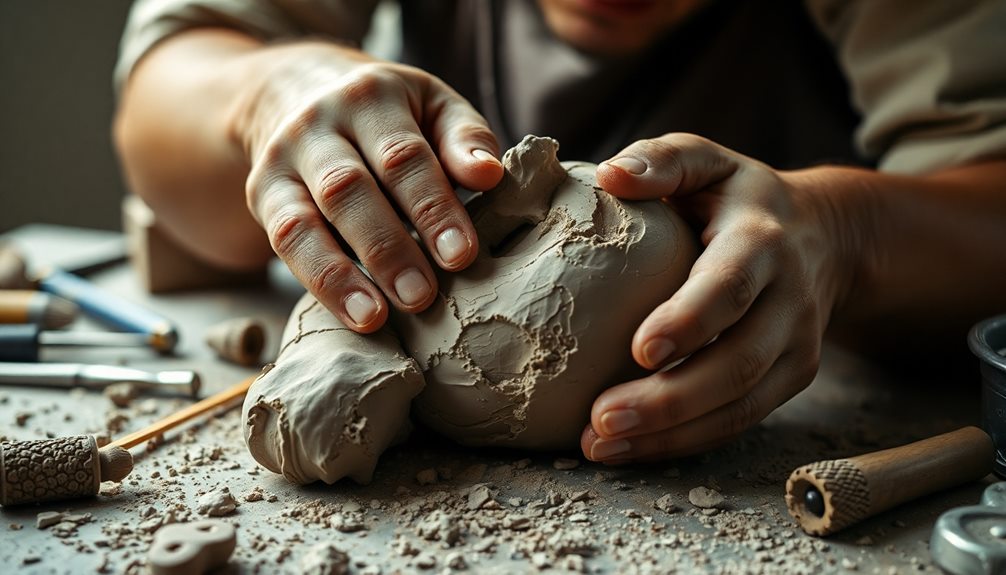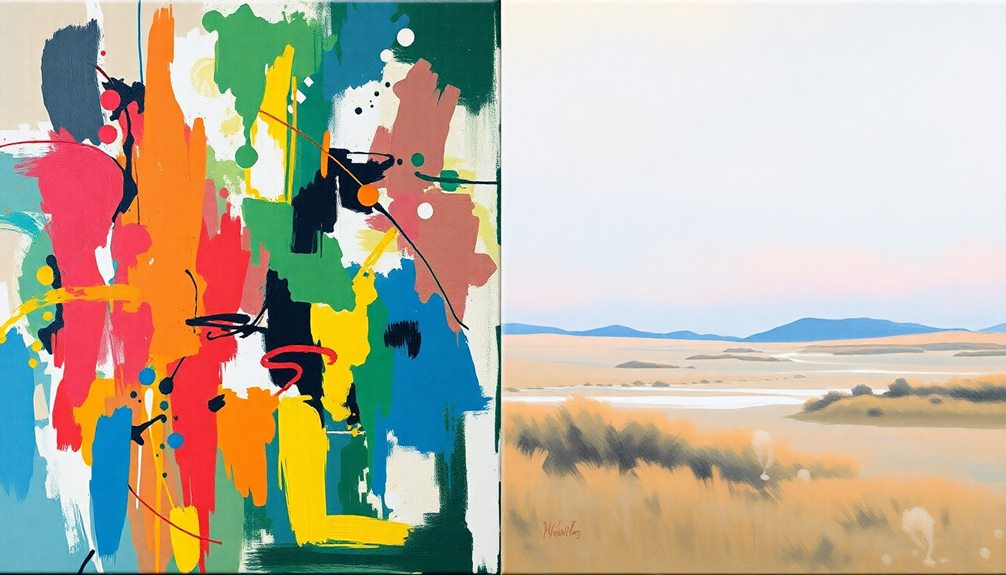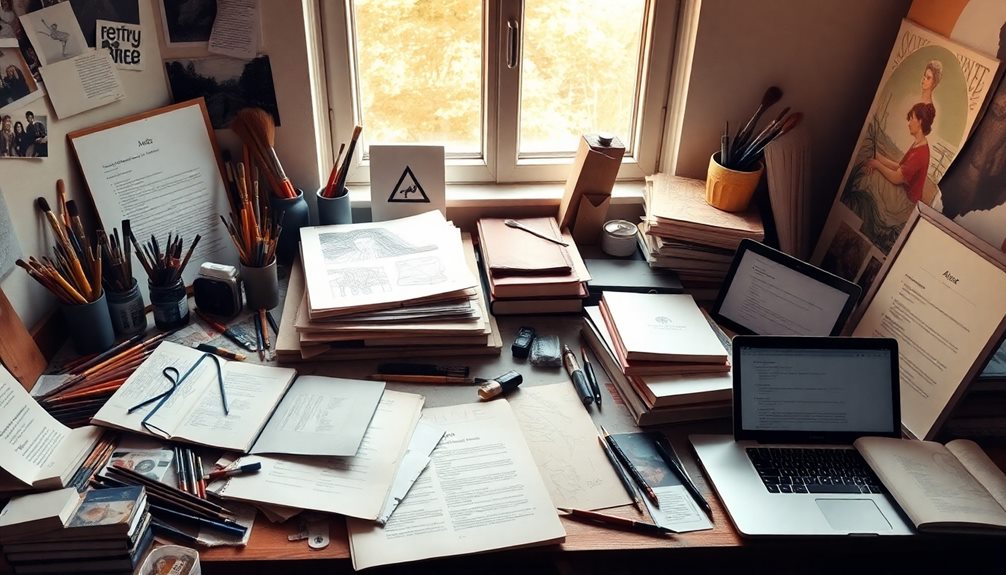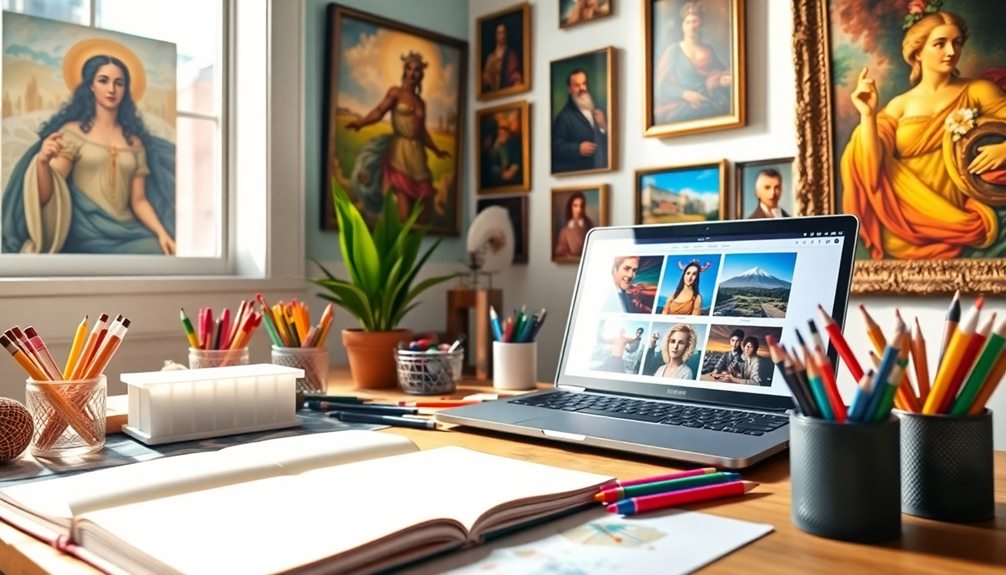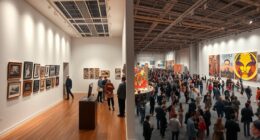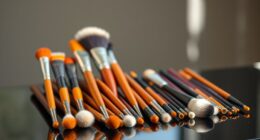When you write about sculpture, focus on its unique three-dimensional qualities. You'll need to consider materials like stone or metal, as they influence texture and form. Scale matters too; it affects emotional responses. Keep in mind the cultural context, since it adds layers of meaning and significance. Don't forget the artist's intent, which can provide deeper insights into the work. Descriptive language is key, as it helps evoke the tactile qualities. By understanding these elements, you'll enhance your analysis. There's much more that can enrich your exploration of this captivating art form.
Key Takeaways
- Focus on the interplay of materials, scale, and artist intent to provide a comprehensive analysis of the sculpture.
- Consider the cultural context and symbolism to enhance interpretation and appreciation of the work.
- Analyze the emotional impact of proportions and physical presence on viewer engagement.
- Explore the historical background of the artist to understand creative influences and societal significance.
- Highlight tactile qualities and light interactions to convey the sculpture's visual experience effectively.
Introduction
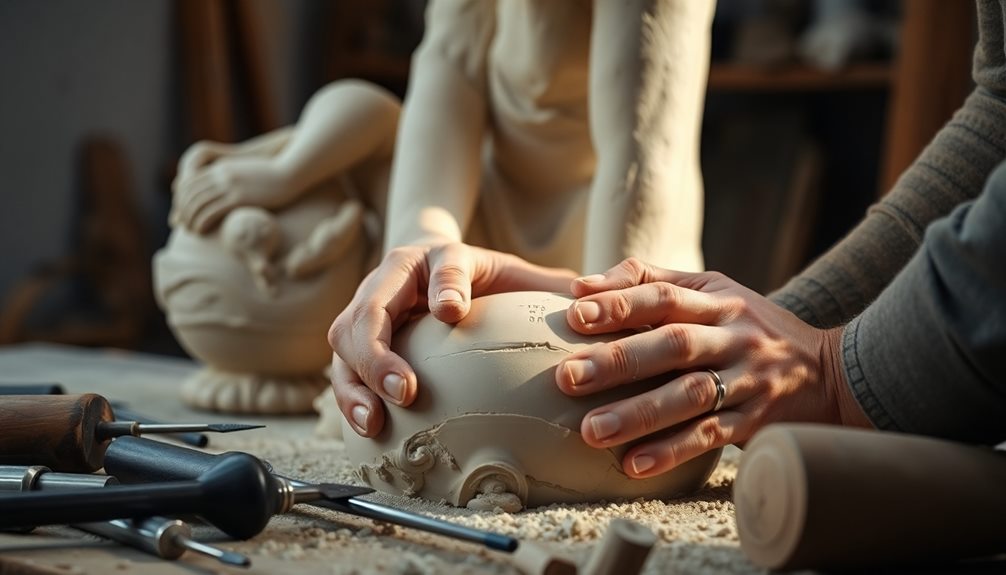
When you write about sculpture, you dive into a medium that transcends the confines of flat artwork, engaging with its unique three-dimensionality. Sculptures interact with light and space, inviting you to consider how these elements affect your viewing experience.
As you analyze a piece, pay close attention to the materials used. Whether it's stone, metal, or wood, the choice of medium significantly impacts the tactile qualities and overall aesthetic.
Scale and proportion are also crucial considerations. The size of the sculpture can evoke different feelings, and how it relates to the human form or its environment can influence your emotional response. For instance, a towering statue might inspire awe, while a smaller piece could invite intimacy.
Don't overlook the artist's intent behind the sculpture. Understanding what the artist aimed to convey provides deeper insight into the work's significance.
Combine these elements—materials, scale, and intent—and you create a well-rounded analysis that resonates with your audience. By thoughtfully considering these aspects, you enhance your writing and bring the sculpture to life for your readers.
Key Concepts and Definitions
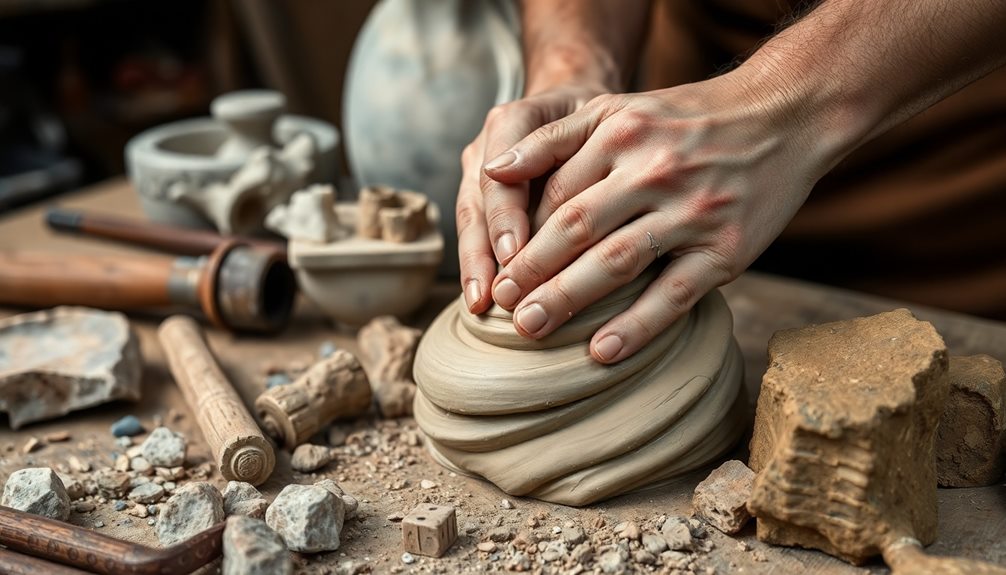
Sculpture is a unique art form that prioritizes form and shape, often drawing inspiration from the natural world. Sculptors explore these elements to convey inner vitality and strength, translating organic inspiration into hard materials like stone and metal. These materials allow for definitive shapes and details that stand in contrast to the softer forms found in other art mediums.
When discussing sculpture, it's essential to understand the concept of monumentality. This idea transcends mere physical dimensions; a small sculpture can evoke a sense of monumentality through its design and how it's represented visually. The sculptor must consider the broader relevance and impact of their work on viewers, ensuring it resonates on multiple levels.
Furthermore, the artistic process in sculpture is a dynamic exploration of form and shape. You'll notice the interplay of tension and pressure, especially between hard and soft elements, which creates a unique expression.
Essential Elements of Sculpture
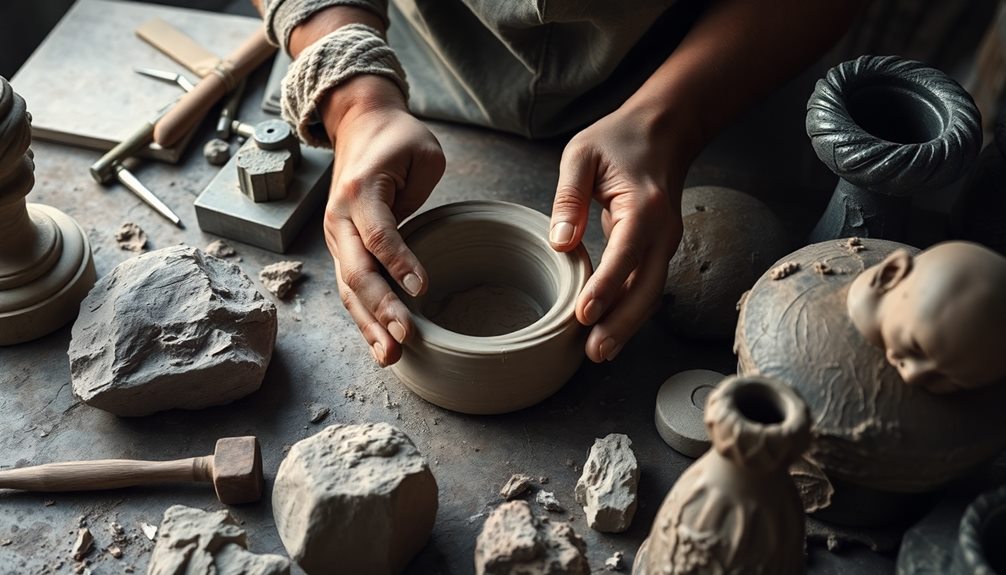
Understanding the key concepts in sculpture sets the stage for exploring its fundamental elements. At the core of sculpture, you'll find a strong emphasis on shape and form. Artists often work with hard materials, utilizing techniques like carving to convey strength and permanence.
The concept of monumentality plays a key role, as it transcends mere size, relying on the artist's vision to evoke significance. Proportions are crucial; artists frequently employ mathematical systems to maintain balance and harmony in their works.
This attention to detail creates a clearly articulated relationship between internal structures and external appearances, enabling dynamic expression. The actual physical presence of a sculpture engages viewers, inviting them to explore its tactile qualities.
Scale and viewer perspective significantly influence your perception. The emotional impact and intended message can shift based on your position relative to the artwork.
It's essential to consider how the sculpture interacts with its environment, as these factors contribute to your overall experience. By understanding these essential elements, you'll be better equipped to appreciate and analyze the intricacies of sculpture in a meaningful way.
Notable Sculptural Installations
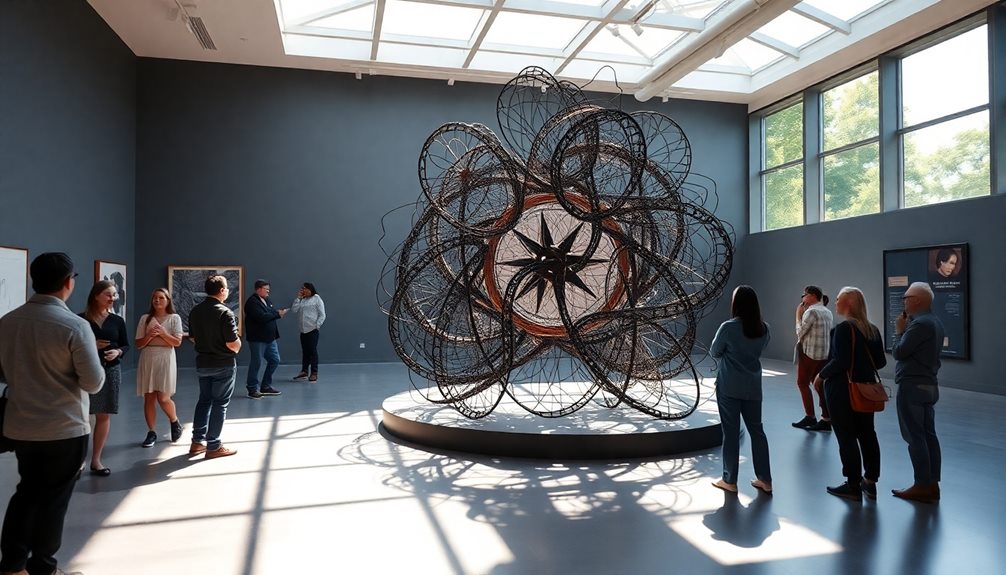
Engaging with notable sculptural installations reveals the powerful connection between art and environment.
Take, for instance, Christo and Jeanne-Claude's "The Gates" in New York's Central Park. This installation features 7,503 saffron-colored fabric gates that span over 23 miles of pathways, transforming the landscape and inviting you to explore the interaction between nature and art.
In Chicago, Anish Kapoor's "Cloud Gate," affectionately called "The Bean," captivates visitors with its reflective surface that distorts the skyline, creating an engaging experience that connects the human body with the surrounding architecture.
Meanwhile, Walter De Maria's "The Lightning Field" in New Mexico showcases 400 stainless steel poles arranged to capture natural phenomena, emphasizing the interplay between human-made and natural elements.
Richard Serra's "The Large One" utilizes massive steel plates to create an immersive experience, altering your perception of space and gravity.
Lastly, Yayoi Kusama's "Infinity Mirror Rooms" offer a mesmerizing blend of sculpture and immersive environments, inviting you to engage with endless reflections that evoke a sense of infinity.
Each installation enhances your understanding of art's role in shaping human experience.
Tips and Best Practices
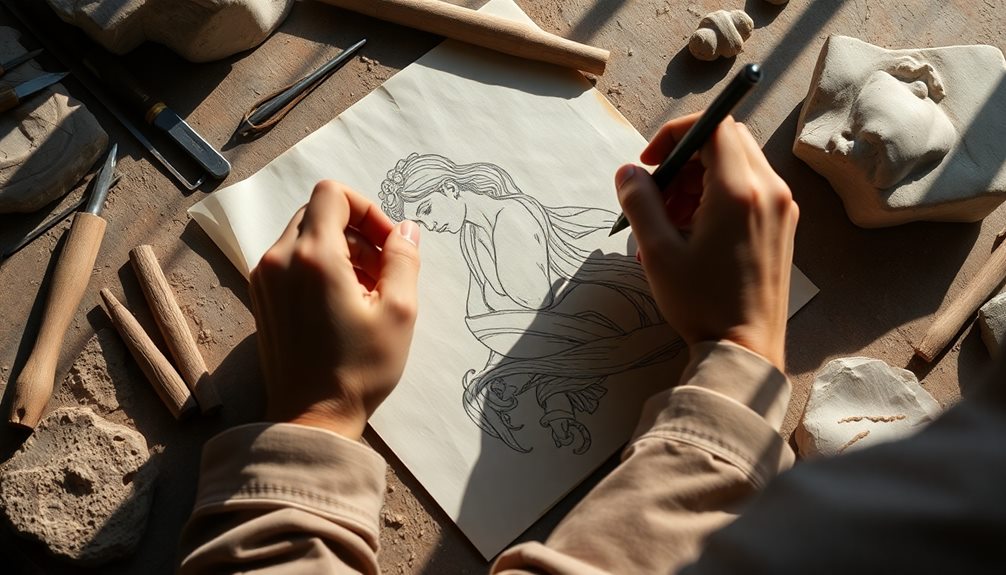
Exploring notable sculptural installations can inspire your own writing about this art form. When you write about sculpture, pay close attention to the medium and techniques used, as these greatly influence both style and visual impact.
Consider the scale of the work in relation to its environment; a large sculpture, like a towering tree trunk, can evoke different emotions than a smaller piece. The use of sustainable materials in contemporary sculptures can also add layers of meaning, as artists often make statements about environmental concerns through their work, reflecting the impact of sustainable materials on artistic expression.
Analyze the proportions and balance within the sculpture, as these elements contribute to its overall stability and aesthetic appeal. Discuss how the sculpture interacts with its architectural context, enhancing your understanding of its purpose and significance. This relationship can reveal deeper meanings and connections.
Don't forget to highlight the tactile qualities of the sculpture. Discuss how material hardness and surface texture convey strength and permanence. For instance, a rough stone surface versus a smooth metal finish can lead to varied interpretations.
Audience Engagement and Feedback

Often, viewers have powerful reactions to sculpture that can shape their interpretation and appreciation of the work. When you write about sculpture, consider how the sculpture's scale and context influence these emotional responses. Use descriptive language to evoke the tactile qualities and physical presence of the piece, making your audience feel as if they're experiencing it firsthand.
Providing historical context about the artist and their techniques can deepen this connection. When readers understand the significance behind the artwork, they're more likely to engage meaningfully with it. Encourage feedback from viewers; their insights can reveal how different audiences perceive the sculpture and can inform your future writing and artistic choices.
Utilizing visual aids, like photographs or diagrams, alongside your descriptions can clarify complex forms and enhance audience engagement. These tools help bridge the gap between written words and the visual experience of the sculpture.
Cultural Context Impacts Interpretation

Understanding the emotional responses viewers have to sculpture is only part of the equation; cultural context plays a significant role in shaping those interpretations. Different societies attribute varying meanings to similar forms and materials, influenced by their unique historical and social narratives.
When you analyze a sculpture, consider the values, beliefs, and traditions that inform its creation. The symbolism embedded within the piece often reflects these cultural elements, impacting how you and others perceive it emotionally.
Sculptural styles and techniques also differ across cultures. While some might prioritize abstraction, others lean toward naturalism, which shapes the intended message and influences audience engagement.
Historical events like colonization or significant social movements can further alter a sculpture's significance over time, leading to reinterpretations that resonate differently with contemporary viewers.
Additional Resources

When researching sculpture, tapping into additional resources can significantly enhance your analysis and appreciation. Start by exploring books and articles that focus on different mediums and techniques. Understanding the materials artists use, especially hard materials that convey strength and permanence, will deepen your insight into their work.
Next, look for resources that discuss scale and proportions. These elements are crucial in shaping a viewer's perception and emotional response, particularly in relation to the environment surrounding the sculpture. Pay attention to how light and shadow interact with the piece; resources on compositional elements can reveal how these factors enhance the sculpture's tactile quality and visual experience.
Don't overlook the concept of monumentality. Seek out discussions that explore how this idea transcends physical size, rooted in the artist's vision and intent.
Finally, dive into the historical context and the artist's background. Understanding these aspects will provide richer meaning and relevance within the art community. Exploring the major art movements overview can further deepen your appreciation for the artwork by situating it within broader trends and innovations that shaped its creation. Learning about the artist’s personal experiences, influences, and philosophical outlook often reveals layers of intention behind their work. This combination of context and history enriches your connection to the piece, offering insight into its significance within both its era and beyond.
With these resources, you'll gain a more comprehensive understanding of sculpture, allowing you to write with confidence and depth.
Frequently Asked Questions
What Are the Factors to Consider When Placing a Sculpture?
When placing a sculpture, consider its scale, viewer interaction, and site relationship. Assess lighting effects throughout the day, ensure accessibility for viewers, and prioritize safety to enhance the artwork's impact and significance.
How Do You Write a Description of a Sculpture?
To write a sculpture description, start with its title, artist, and medium. Then, explore its shapes, textures, themes, and materials. Finally, consider how it interacts with its environment to enrich the viewer's experience.
What Is Special About Sculptures?
Sculptures stand out because they invite you to engage with them from various angles, showcasing their three-dimensionality. Their use of durable materials and unique techniques creates a tactile experience that captures light and shadow beautifully.
How to Write an Analysis of a Sculpture?
To write an analysis of a sculpture, start by examining its scale, materials, and composition. Consider how these elements interact with light and historical context to deepen your understanding and interpretation of the artwork.
Conclusion
In conclusion, when writing about sculpture, remember to embrace its unique qualities and the emotions it evokes. Keep key concepts and essential elements in mind, and don't hesitate to explore notable installations for inspiration. Engaging your audience and considering cultural contexts will enhance your insights and interpretations. By following these tips and best practices, you'll create a compelling narrative that captures the essence of sculpture and fosters a deeper appreciation for this art form.
